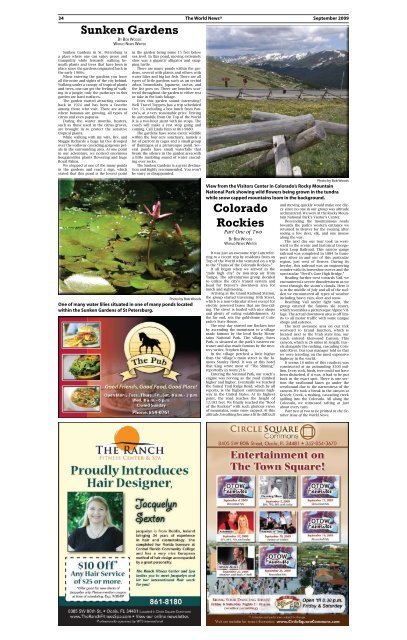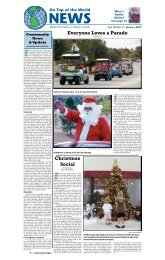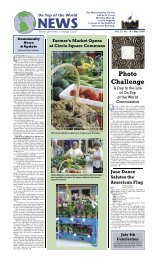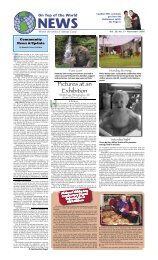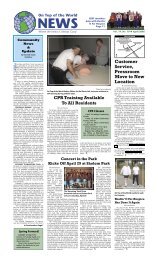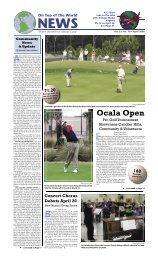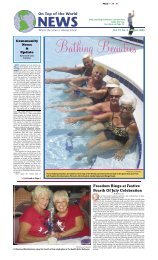34 The <strong>World</strong> News® <strong>September</strong> <strong>2009</strong>Sunken GardensBy Bo b Wo o d sWo r l d Ne w s Wr i t e rSunken Gardens in St. Petersburg isa place where one can enjoy peace andtranquility while leisurely walking beneathplants and trees that have been inplace since <strong>the</strong> gardens originated back in<strong>the</strong> early 1900s.When entering <strong>the</strong> gardens you leaveall <strong>the</strong> noise and sights <strong>of</strong> <strong>the</strong> city behind.Walking under a canopy <strong>of</strong> tropical plantsand trees, one can get <strong>the</strong> feeling <strong>of</strong> walkingin a jungle; only <strong>the</strong> pathways in thisgarden are hard surfaces.The garden started attracting visitorsback in 1924 and has been a favoriteamong those who visit. There are areaswhere bananas are growing, all types <strong>of</strong>citrus and even papayas.During <strong>the</strong> winter months, heaters,such as those used in <strong>the</strong> citrus groves,are brought in to protect <strong>the</strong> sensitivetropical plants.While walking with my wife, Bev, andMaggie Richards a huge lai tree droopedover <strong>the</strong> walkway cascading gorgeous petalsin <strong>the</strong> surrounding area. At one pointin our adventure, we noticed enormousbougainvillea plants flowering and hugeRoyal Palms.We stopped at one <strong>of</strong> <strong>the</strong> many pondsin <strong>the</strong> gardens and read a sign, whichstated that this pond is <strong>the</strong> lowest pointin <strong>the</strong> garden being some 15 feet belowsea level. In this pond, moving extremelyslow was a gigantic alligator and snappingturtle.There are many ponds within <strong>the</strong> gardens,several with plants and o<strong>the</strong>rs withwater lilies and big koi fish. There are alltypes <strong>of</strong> little gardens such as an orchidarbor, bromeliads, Japanese, cactus, and<strong>the</strong> list goes on. There are benches scatteredthroughout <strong>the</strong> garden to ei<strong>the</strong>r restor take in <strong>the</strong> lush foliage.Does this garden sound interesting?Well Travel <strong>Top</strong>pers has a trip scheduledOct. 15, including a box lunch from Panera’s,at a very reasonable price. Drivingby automobile from <strong>On</strong> <strong>Top</strong> <strong>of</strong> <strong>the</strong> <strong>World</strong>it is a two-hour jaunt with no stops. Thecoach will make a rest stop going andcoming. Call Linda Hein at 861-9880.The gardens have some exotic wildlifewithin <strong>the</strong> four-acre sanctuary, namely alot <strong>of</strong> parrots in cages and a small group<strong>of</strong> flamingos at a picturesque pond. Severalponds have small waterfalls thatbreak <strong>the</strong> silence in <strong>the</strong> garden area witha little rumbling sound <strong>of</strong> water cascadingover rocks.The Sunken Gardens is a great destinationand highly recommended. You won’tbe sorry or disappointed.Photo by Bob Woods<strong>On</strong>e <strong>of</strong> many water lilies situated in one <strong>of</strong> many ponds locatedwithin <strong>the</strong> Sunken Gardens <strong>of</strong> St Petersburg.Photo by Bob WoodsView from <strong>the</strong> Visitors Center in Colorado’s Rocky MountainNational Park showing wild flowers being grown in <strong>the</strong> tundrawhile snow capped mountains loom in <strong>the</strong> background.ColoradoRockiesPart <strong>On</strong>e <strong>of</strong> TwoBy Bo b Wo o d sWo r l d Ne w s Wr i t e rIt was just an awesome trip! I am referringto a recent trip by residents from on<strong>Top</strong> <strong>of</strong> <strong>the</strong> <strong>World</strong> who ventured on a tripto <strong>the</strong> “Trains <strong>of</strong> <strong>the</strong> Colorado Rockies.”It all began when we arrived in <strong>the</strong>“mile high city” by non-stop air fromTampa. The adventurous group decidedto utilize <strong>the</strong> city’s transit system andhead for Denver’s downtown area forlunch and sightseeing.Arriving at <strong>the</strong> Grand Railroad Station,<strong>the</strong> group started traversing 16th Street,which is a non-vehicular street except forelectric powered buses that are free-riding.The street is loaded with nice shopsand plenty <strong>of</strong> eating establishments. At<strong>the</strong> far end, sits <strong>the</strong> gold-dome <strong>of</strong> Colorado’sState House.The next day started our Rockies tourby ascending <strong>the</strong> mountains to a villagemade famous by <strong>the</strong> local Rocky MountainsNational Park. The village, EstesPark, is situated at <strong>the</strong> park’s eastern entranceand also made famous by <strong>the</strong> mysterywriter, Stephen King.In <strong>the</strong> village perched a little higherthan <strong>the</strong> village’s main street is <strong>the</strong> famousStanley Hotel. It was at this hotelthat King wrote most <strong>of</strong> “The Shining;”reportedly in room 216.Entering <strong>the</strong> National Park, our coach’sengine was revving as <strong>the</strong> road climbedhigher and higher. Eventually we reached<strong>the</strong> famed Trail Ridge Road, which by allreports, is <strong>the</strong> highest continuous highwayin <strong>the</strong> United States. At its highestpoint, <strong>the</strong> road reaches <strong>the</strong> height <strong>of</strong>12,183 feet. We finally reached <strong>the</strong> “Ro<strong>of</strong><strong>of</strong> <strong>the</strong> Rockies” with such glorious views<strong>of</strong> mountains, some snow capped. At thisaltitude, breathing became a little difficultand moving quickly would make one dizzysince no one in our group was altitudeacclimatized. We were at <strong>the</strong> Rocky MountainNational Park’s Visitor’s Center.Descending <strong>the</strong> mountainous roadstowards <strong>the</strong> park’s western entrance wereturned to Denver for <strong>the</strong> evening afterseeing a few deer, elk, and one moosealong <strong>the</strong> way.The next day our tour took us westwardto <strong>the</strong> scenic and historical GeorgetownLoop Railroad. This narrow gaugerailroad was completed in 1884 to transportsilver in and out <strong>of</strong> this particularregion, just west <strong>of</strong> Denver. During itsheyday, this railroad was an engineeringwonder with its horseshoe curves and <strong>the</strong>spectacular “Devil’s Gate High Bridge.”Heading fur<strong>the</strong>r west towards Vail, weencountered a severe thunderstorm as wewent through <strong>the</strong> storm’s clouds. Here itis in <strong>the</strong> middle <strong>of</strong> July and all <strong>of</strong> <strong>the</strong> suddenwe encountered all types <strong>of</strong> wea<strong>the</strong>rincluding heavy rain, sleet and snow.Reaching Vail under light rain, <strong>the</strong>group entered <strong>the</strong> famous ski resort,which resembles a picturesque Alpine Village.The actual downtown area is <strong>of</strong>f limitsto all motor traffic with some uniqueshops and eateries.The next awesome area on our trekwestward to Grand Junction, which islocated next to <strong>the</strong> Utah state line, ourcoach entered Glenwood Canyon. Thiscanyon, which is 26 miles in length, travelsalongside <strong>the</strong> rushing, cascading ColoradoRiver. Our tour manager told us thatwe were traveling on <strong>the</strong> most expensivehighway in <strong>the</strong> world.It seems 16 miles <strong>of</strong> this roadway wasconstructed at an astounding $500 million.Every rock, bush, tree could not havebeen disturbed, if it was, it had to be putback in <strong>the</strong> exact spot. There is one section<strong>the</strong> eastbound lanes go under <strong>the</strong>westbound due to <strong>the</strong> narrowness <strong>of</strong> <strong>the</strong>canyon. We took a break in <strong>the</strong> canyon atGrizzly Creek, a rushing, cascading creekspilling into <strong>the</strong> Colorado. All along <strong>the</strong>Colorado, we witnessed rafting at justabout every turn.Part two <strong>of</strong> two to be printed in <strong>the</strong> Octoberissue <strong>of</strong> <strong>the</strong> <strong>World</strong> News.
<strong>September</strong> <strong>2009</strong> The <strong>World</strong> News® 35For SaleBicycle: 3-month-old men’s 26” Avalon 7speed with helmet, pump & lock. $85/OBO.861-4812.Bicycle: Panasonic, 26” 10-speed, hardlyused. Make <strong>of</strong>fer. 854-6316.Blinds: Four white wood-look Venetianblinds for 48” x 62” windows, ideal for lanai.622-2266China Closet: Large two piece rosewoodwith decorative carvings and glass doors.Can deliver in <strong>On</strong> <strong>Top</strong> <strong>of</strong> <strong>the</strong> <strong>World</strong>. Call547-1469.Computer Cabinet: cherry, excellent condition.Approx. 70” high x 40” wide. 12 pigeonholes with file drawer. $200. 861-2165.Electrolux Rug Shampooer: make an <strong>of</strong>fer.Please call 237-2939 after 5 p.m.Electronics: Color scanner (color, legal/letter),camera with mike for on-line internet,printers, earphones with mike and more;Gateway computer with XP and 19” colormonitor; 35 mm camera with 52mm and62/200 lenses; digital camera with works;Panasonic telephone system. Make <strong>of</strong>fer.854-6316.Estate Sale: Friday and Saturday, Sept. 25and 26, 9 a.m. - 1 p.m., 9750 SW 97th Pl.,Crescent Ridge II.European Artwork: Handmaiden statuein gold, turquoise and cream on pedestal.Reasonable. 216-7509 or 854-7516.Furniture: Recliner, modern black lea<strong>the</strong>rwith ottoman, $225. 36” round oak table withtwo teak chairs, s<strong>of</strong>t seats, $275. Large oakmodern desk with mail hutch $375. Large5’, 7 drawer dresser, light knotty pine, $150.Blanket chest, teak wood, 4’ x 18” x 15”,$225. Large folding teak table folds down to8” wide; open 63” x 34”, $275. Modern lightoak s<strong>of</strong>a table, $95. Can deliver in OTOW.547-1469.Furniture: 48” round white table, fourchairs with wheels, blue and gray cushions.Good condition. 622-2255.Furniture: Taupe ultra suede s<strong>of</strong>a, $175.Taupe ultra suede loveseat, $150. Both invery good condition. 861-9144.Golf Cart: 2004 E-Z-Go. Rebuilt in 2007.854-7858Golf Cart: E-Z-Go. Must sell. 237-6062.Golf Cart: Par Car, 07, new condition, burgundy.873-8600Golf Clubs: 1, 2, 5 woods, lightweight,midflex, new grips. Extra long for distance.$150. 873-4759Golf Clubs: Callaway, Big Bertha X12 irons,2 thru 9 plus sand and pitching wedge, pingdriver, golf bag, balls. 291-6964Grill: Full size table top with ss grid. Includes2 gas bottles. Make <strong>of</strong>fer. 854-6316.Hand Trucks: Flat bed/upright hand, $5.3-tier steel service cart, new, $25. Make <strong>of</strong>fer.854-6316.Keyboard: Yamaha portable grand, 77keys, like new $125. 873-4759King Headboard <strong>On</strong>ly, no rails. Custommade, padded and upholstered. Whitebackground with pastel color design. Beautiful,like new. $100 firm. 861-8852.Landscaping Pots: New, very large,cheap. 873-1745.Love Seat, Chair and Ottoman: Brick colored,matching. 237-9073Misc. Items: Craftsman portable air compressor,one hp, new, $75. Spray gun, onequart capacity, $15. Hobby air brush, $12.Air brush kit, $10. 854-8220.Misc. Items: Desk model rotary sewingmachine, $25. Glass top table and chairs(patio), $30. 873-0579Misc. Items: Elegant carved mahoganypedestal table, carved palm leaves holds48” beveled round glass top. Four chairswith white seats, contemporary or traditional.Antique-looking gold chandelier, 5 lightsand 1 down light, $125. 237-9522.Misc. Items: Large electric roasting pan,used twice, $10. New Scrabble game, $5.861-9177Misc. Items: Lowry Genius Three keyboard,15 pedals organ, negotiable. 80”pastel flora s<strong>of</strong>a, $26. Dining room table, 65x 40 with four chairs, $350. Wooden porchglider, $45. 854-8220.Carolyn’s Cleaning Service, Inc.Lic. A39058 & InsuredServing Ocala & Surrounding AreasThe Best House Cleaning at <strong>the</strong> Best Price!Two bedroom starts at $49 • Three bedroom/two baths start at $59Call 368-2247for a free price quoteSatisfaction guaranteedClassified SectionDEADLINE: noon on <strong>the</strong> 13th <strong>of</strong> <strong>the</strong> month. If <strong>the</strong> deadline falls on a weekend, <strong>the</strong>n it’s noonon <strong>the</strong> Friday before.FOR SALE, WANTED AND LOST/FOUND ADS: There is no charge to residents as long as it is not<strong>of</strong> a business nature. There is a $500 limit on FOR SALE items. Items valued at more than$500 (i.e. golf carts) may be listed, but price will not accompany <strong>the</strong> ad. Auto, apartment,home, timeshare and real estate ads WILL NOT be accepted. Ads will appear once unlessrenewed in writing.SERVICE ADS: Will be accepted from residents and non-residents. A three-line minimum (21words) rate is $20; four lines (28 words) is $25 and five lines (35 words) is $30. A six-monthrate is also available; call 854-0248 or e-mail otownews@otowfl.com for more information.PAYMENT: Prepayment is required and checks should be made payable to Palm Acre RealEstate/The <strong>World</strong> News. Send ad and payment to The <strong>World</strong> News, 9850 S.W. 84th Court,Suite 300, Ocala, FL 34481.OTHER: Ads can be e-mailed to otownews@otowfl.com or left in <strong>the</strong> mailbox next to <strong>the</strong>Pressroom door (in Friendship Commons next to Customer Service).Misc. Items: Red cloth s<strong>of</strong>t, chair and ottoman,4-1/2 years old, $100. Tall glass toppatio table and two chairs, $50. 854-2280.Misc. Items: Twin size, extra long, adjustablebed with pad, 2 sets sheets, pillow andspread; 52” Hitachi TV. Hawk Ultra Scrollsaw with magnifier and stool; Craftsman 8”wheel bench grinder; 9” Keyless drill press.Craftsman vice; Little Giant ladder; bandsaw. 873-1416Slow Cooker: With meat rack. Make <strong>of</strong>fer.854-6316.Tag Sale: 9212 SW 91 Cir. W., Friday andSaturday, Sept. 4 and 5, 8 a.m. to noon.Singer sewing machine, oak sewing cabinet,computer printer, desk, etc.Tag Sale: Saturday, Sept. 12, 9 a.m.-2 p.m.Wicker: settee/chair/rocker with cushions,all or part. Lots <strong>of</strong> misc., some old, somenew, all loved. 8832A SW 94 Lane, FriendshipVillage.Train Set: Lionel Sante Fe passenger trainset plus 4 extra cars; 027 scale. Two B&Ogondola cars with 2 canisters. Two WesternPacific hopper cars. New in original boxes,never been used. $340. 237-4242TV and Cabinet: 24” RCA TV and cabinet,with remote, 5 years old. Cable ready forstandard cable. Cabinet in excellent condition,top shelf for components, double dooron bottom for storage, dark wood. Both for$100. 390-3853 after <strong>September</strong> 4.TVs/Players: Color TV’s, 13”, 26” and 19”with VHS recorder/player; 57” rear projectionHDTV ready; 2 DVD players, 1 VHSrecorder/player. Make <strong>of</strong>fer. 854-6316.ServicesBest FriendCaregiving/CompanionMeal Preparation • TransportationPersonal Hygiene • Light HousekeepingBeth Bosse861-9548Alterations by Betty: Alterations by appointmentonly. 50 years’ experience. APine Run resident. Call Betty at 237-9909.Alterations by Ernestine: Alterations, experienced.<strong>On</strong> <strong>Top</strong> <strong>of</strong> <strong>the</strong> <strong>World</strong> resident.Call 861-0259.Alterations / Tailor / Curtains / Draperies:Pick-up at your home weekly. To schedulean appointment, call Diana at 401-0076.Appliance, A/C & Heat Repairs. Electrical& plumbing. Experienced and honest. CallTom Parker (<strong>On</strong> <strong>Top</strong> <strong>of</strong> <strong>the</strong> <strong>World</strong> resident)anytime at 873-1297.Bob’s Screening Service: Garage doorscreens, window screens, porch enclosurescreens. We re-vinyl windows. Completerescreening service. Free estimates. 352-586-8459, Bob.Carpet Cleaning: Countryside Chem-Dry,serving <strong>On</strong> <strong>Top</strong> <strong>of</strong> <strong>the</strong> <strong>World</strong> residents fornine years. Dry in hours, not days. 10 percent<strong>of</strong>f first-time clients. 307-4100.Cat and/or House Sitting Services for <strong>On</strong><strong>Top</strong> <strong>of</strong> <strong>the</strong> <strong>World</strong> residents. Dependable,trustworthy and affordable. Referencesprovided upon request. Grammy Sharon,694-4853.Cat Boarding and Sitting provided by lovingexperienced Cat Nanny. <strong>On</strong> <strong>Top</strong> <strong>of</strong> <strong>the</strong><strong>World</strong> resident. Call 854-8589.C.A.T. Woodworking: Crown molding,chair railing and cabinet drawer slides pr<strong>of</strong>essionallyinstalled. We build and repairfurniture. Free estimates, LLC and insured.Call Tom, 288-6148.Cat Care: one glance equals love! Will loveyours, like my own. Experienced, trustworthy& you get peace-<strong>of</strong>-mind. 291-1862.Certified Nursing Assistant: 24 hrs,baths, hourly service, your home or mine.237-7836 or 954-483-4936. #CNA76425.Cleaning by Evelyn Lee: I do windows,deep cleaning, move outs. Lic. #A27450 &insured. 629-0855. www.sunshinecleaningocala.com.Computer Repair: Hardware/s<strong>of</strong>tware repairs,virus/spyware removal, networking,consulting & training. Call Troy’s ComputerClinic at 817-2834.Computer Setup and Training: At homeservice. Senior rates, $25 per hour! Havefun and learn! Call Kathy at 861-7719.Crown Moulding Specialist, pressurecleaning, window cleaning, painting, tile,wallpaper removal, home repair/improvement,stucco repair, complete lawn care,handyman services. Free estimates. AnthonyBellamy 425-5788.Custom Drapery Makers: Valances, cornices,pillows, fabrics, etc. Free estimate.<strong>On</strong> <strong>Top</strong> <strong>of</strong> <strong>the</strong> <strong>World</strong> resident. Dix’s 854-5572 or 209-1444.Experienced Licensed Massage Therapist:Swedish, deep tissue and faceliftmassage. <strong>On</strong> <strong>Top</strong> <strong>of</strong> <strong>the</strong> <strong>World</strong> resident.(352) 237-7042.Garden Maintenance: weeding, edging,trimming, planting and mulching. Any yardwork. 861-9366.Grocery Shopping Service: Provide mewith your grocery list and I take care <strong>of</strong> <strong>the</strong>rest. Reasonable fee, resident. 237-9073.Hair care in your home: Licensed, experiencedbeautician comes to you. Full service.Call Cathy, PCA, resident, 237-3347.Service homebound.Handy-Helper: driveways painted, lightlandscaping, wash windows, shampoocarpets; anything you need. <strong>On</strong> <strong>Top</strong> <strong>of</strong> <strong>the</strong><strong>World</strong> resident. 291-6964.Handyman: Kruman Services, Inc. Licensedand insured. Remodeling, repairs,replacements and preventive maintenance.Call Daniel at 361-4055.Handyman Services by Oden Inc. Lowand fair prices for any type <strong>of</strong> home repair,remodeling, landscape maintenance, pressurewashing and gutter cleaning. Lic & Ins.For free estimates, call: 207-5930.Help-U-Fix-It! We do honey “do’s” and oddjobs! Installations, repairs, renovations,maintenance. Keep up your properties. Call(352) 694-3366.Home Sewing: cushion covers, bed skirts,dinette seats, pillows, tablecloths and napkins.<strong>On</strong> <strong>Top</strong> <strong>of</strong> <strong>the</strong> <strong>World</strong> resident. Call237-6760.HouseCall Senior Home Care <strong>of</strong>fers hourlyservices such as housekeeping, laundry,meal preparation, transportation, familyrespite. Lic. #231040, bonded & insured.(352) 873-0721.Laminated wood floor installation: Qualitywork at reasonable rates. Free estimates.I am a resident. Call Bob at 237-7452.Landscaping: Beautify your yard andhome! Trimming, weeding, edging, pressurewash driveways and gutters, washwindows and general maintenance. <strong>On</strong> <strong>Top</strong><strong>of</strong> <strong>the</strong> <strong>World</strong> resident. Steve at 237-5338.Lawson TileFloor Tile • Wall TileBath Remodelling • Back SplashQuality Work • Reasonable RatesAlan Lawson . 31 Years Experience(352) 229-5548Barney’sGarage Door& OpenerSales & ServiceAll Makes &ModelsMaintenance& Repair(352) 595-5041Massage Therapy: in home massage forpain management & relaxation. By localmassage school instructor Greg Sharko.Fla. Lic. MA31293. 390-3653.Notary Services and Signing Agent: Willcome to your home. Bonded, insured. Reasonablerates. Call Kathylee at 861-6965.<strong>On</strong> <strong>Top</strong> <strong>of</strong> <strong>the</strong> <strong>World</strong> resident.Painting by Ben Travis: $99 per roomspecial. <strong>On</strong>e coat <strong>of</strong> any pastel color in anyroom. $99 includes Sherwin Williams Best“Duration.” Clean, reliable service by Lic. &ins. contractor. 30 yrs. exp. & referenceslist. Free est. 620-5370.Painting by Bruce LLC: 38 years’ experience.Free estimates. Interior, exterior,staining, drywall repair, pressure washing,specializing in repaints. Licensed, insured.(352) 546-4553.Painting by Frank <strong>the</strong> Painter: Free estimates,interior painting, specializing incolors, quality service, affordable prices, 30years’ experience and licensed, summerspecials. 237-5855Painting by Johnson’s Painting Services:Reliable, 15 year’s exp. Lic & Ins. Pleasecall for a fair and reasonable estimate: 207-6620.Pipe leak damage your home? Whatnext? Call us first; Right Side Claim Advisors888-779-6895.Pressure Washing: “Don’s” Free estimates.Remove mildew from driveways,porches, patios, walkways and clean <strong>the</strong>gutters. <strong>On</strong> <strong>Top</strong> <strong>of</strong> <strong>the</strong> <strong>World</strong> resident. 873-6225.Pressure Washing: house or driveways.Call <strong>On</strong> <strong>Top</strong> <strong>of</strong> <strong>the</strong> <strong>World</strong> resident, Okey.Free estimate 237-6637.Steve’s Handyman Service: Doors, shelving,general carpentry. <strong>On</strong> <strong>Top</strong> <strong>of</strong> <strong>the</strong> <strong>World</strong>resident. Call Steve at 854-4927Transportation: Call Bonnie, <strong>On</strong> <strong>Top</strong> <strong>of</strong> <strong>the</strong><strong>World</strong> resident, to doctors, hospitals, shopping;excluding airports. Dependable, safedriver. 854-7516Transportation: I’ll drive you to local appointments,grocery shopping, errands andmore. Joan at 237-8240Transportation: Personalized door-todoortransportation to airports, cruise ports,doctor appointments, shopping. Call Betty,861-1163.WantedBowlers for <strong>On</strong> <strong>Top</strong> <strong>of</strong> <strong>the</strong> <strong>World</strong>’s MondayLeague. Starting Sept. 14, league bowlingwill be Monday’s at 3 p.m. at Galaxy West.Call Chris 873-8187 or Joan 237-1978.Bowlers for fun, non-sanctioned <strong>On</strong> <strong>Top</strong> <strong>of</strong><strong>the</strong> <strong>World</strong> league. Men, women or completeteams needed. League bowling on Thursdaysat 3 p.m. beginning Sept. 10. Call Jim873-1281 or Joe 854-8960.Buying all types <strong>of</strong> items: Furniture,glassware, jewelry, gold, guns, tools, militaryitems, fishing gear, old trains, sterlingsilver, automobiles, statues, figurines & golfcarts. Call Marty 274-3178.Guns: <strong>On</strong> <strong>Top</strong> <strong>of</strong> <strong>the</strong> <strong>World</strong> resident interestedin buying guns, new, old, any condition.854-2555.LostLarge Golf Umbrella: red and white, widepink rubber band on handle. 873-2171.Tired <strong>of</strong> looking atyour outdatedpopcorn ceiling?• Popcorn ceiling removal - clean,quick and surprisingly affordable• Modernize your home by removingyour outdated popcorn ceiling• State licensed and insured• The only drywall contractorauthorized by <strong>On</strong> <strong>Top</strong> <strong>of</strong> <strong>the</strong> <strong>World</strong>• We also do quality drywall repairslarge or smallHave popcornremoved from entirehome and receive$50 OFFFree estimates,call today!352-812-3298


